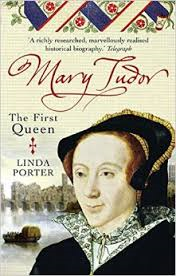Linda Porter (author of ‘Mary Tudor: The First Queen’ and ‘Katherine the Queen: The Remarkable Life of Katherine Parr’) has very kindly answered by questions relating to Mary Tudor and Lady Jane.
Thank you Linda.
What does your book add to the existing works about Mary Tudor?
My book was the first of three new biographies (two popular, one academic) about Mary Tudor that came out within a few years of each other, though at the time mine was commissioned I had no idea that there were any others in preparation. Broadly speaking, we all took the same view, that Mary Tudor had been much-reviled by history as an embittered failure while she was in fact a conscientious, hard-working monarch, well-educated and a survivor of one of the most violent and dramatic periods in English history.
My Mary was not some sad little woman who was a humourless bigot but a much more complex figure who loved gambling, dancing, fine clothes and jewellery and presided over a cultured court. She was also brave and loyal to those who loved her, a fine orator, committed to the reform of Catholic religion in England and had a good grasp of government. And scarcely known to many, she had effectively been a surrogate mother to her much younger half-siblings, Elizabeth and Edward, during their early childhood, when the three often lived together. Mine was the first book to present a more rounded picture of Mary and readers have been kind enough to say that it is still the only one that really lets you get to know her.
I never sought to deny the persecution of Protestants that took place during her reign, but the propaganda that blackened Mary’s name (begun during Elizabeth’s reign) highlighted just one aspect of her rule and carefully overlooked her achievements in reforming local government and the exchequer. Religious toleration as a concept would simply have been anathema to the 16th century mind and we should not judge other ages by our own. Mary was our first queen regnant and she named Elizabeth as her successor for the good of the country, (though they were at loggerheads for much of Mary’s reign), a responsible action that Elizabeth could never bring herself to emulate when she was queen. Above all, I wanted to challenge the general perception that Mary’s reign was a ghastly aberration best forgotten.
Was gaining the throne Mary’s greatest achievement? If not, what do you think was?
I think gaining the throne probably was Mary’s greatest achievement, but the fact that she managed to pass it on peacefully to Elizabeth is not far behind.
‘Through a happy accident of timing, the duke’s new daughter-in-law provided him with the means to retain power when Edward was gone.’ (p190) Do you think Northumberland was aware of Edward’s ‘Devise for the Succession’ when he married his son to Lady Jane?
The general view is that Northumberland probably did know about Edward’s ‘Devise’, but only in the sense that he took a keen interest in preparing Edward for government and would have been familiar with the king’s studies. The use to which the ‘Devise’ could be put seems to have occurred to him only after the Jane Grey marriage, as Edward’s health deteriorated rapidly. There is no evidence that the idea originated with Northumberland; it seems to have been Edward’s own.
You state that Robert Wingfield in the ‘Vita Mariae Reginae’ writes that, ‘Jane… encouraged her father to go.’ (p. 207) Why do you think Jane has been portrayed as asking the Duke of Suffolk not to lead the armed response against Mary?
I guess because it fits in with male historians’ views of a nervous queen who needed her father to be with her. It’s part of the ‘Jane as victim’ view of history. From what we know of Jane, she was not nervous at all! Robert Wingfield was a contemporary and his account is an important source.
The description you give of Queen Jane is based on the only contemporary account by Baptista Spinola. In the paperback version of her book ‘The Sisters Who Would Be Queen’ (published 2010); Leanda de Lisle argues that the letter and description are a fake. Do you have an opinion about this?
I know Leanda has looked into this very carefully and it is not uncommon to discover that apparently contemporary descriptions from this period are fake. (No one has challenged Wingfield’s veracity, however.) The Italians were particularly guilty – Leti’s Italian Life of Elizabeth contains a number of documents that he seems to have concocted himself. It is very easy for dates, descriptions etc that were always taken as fact to be mistaken.





































